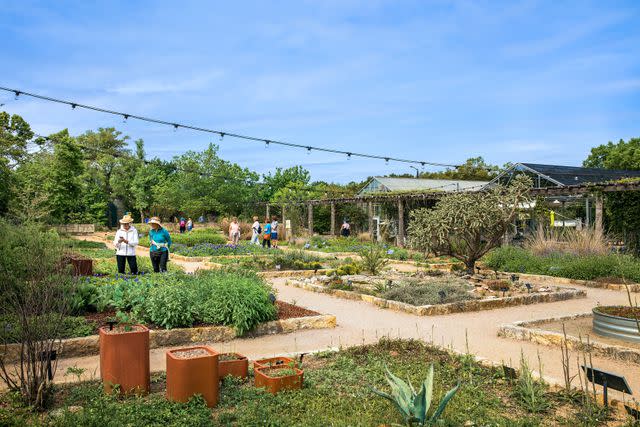See The Best Of Texas’ Bluebonnets At Lady Bird Johnson’s Wildflower Center
- Oops!Something went wrong.Please try again later.
- Oops!Something went wrong.Please try again later.
The former First Lady made it her mission to bring back the wild plants that make the world more beautiful—one seed at a time.
:max_bytes(150000):strip_icc():format(jpeg)/27599_LBJWildflowerCenterExtrasMuleShoeANDLlano-3731_preview1-cbe3a2817e67448b920ca79b343024d0.jpg)
Wynn Myers
Catch an unforgettable view of the Hill Country blossoming into color at public parks like Muleshoe Bend Recreation Area.Not long after moving to Texas, I started noticing the flowers. It might seem incongruous with the unmistakably scorching summer temperatures and cacti that tend to come to mind when imagining the great Lone Star State. However, pay attention, and you’ll see the happy little blooms that brightly daub each side of the highway. Fiery red Indian paintbrushes and cheery yellow coreopsis offer the eyes a colorful respite from the sun-bleached asphalt and the persistent floating haze of heat. And, of course, there are the spring bluebonnets (Texas’ famous state flower) blanketing every grassy surface, along quiet stretches of country roads and traffic-jammed four-lane city streets.
There’s perhaps nowhere that these native plants put on a more marvelous display than at the Lady Bird Johnson Wildflower Center, southwest of downtown Austin. Founded by Lady Bird Johnson and actor Helen Hayes in 1982, the 284-acre state botanic garden and arboretum is home to over 10,000 species from all across Texas, the most diverse collection of such in North America. As you wander the many lush exhibits—maintained year-round by dedicated staff members, green-thumbed volunteers, and a sustainable irrigation system bolstered by rainwater collection—it’s easy to see that this is no stuffy, straight-hedged place.

Wynn Myers
Why You Should Visit
Rather than attempting to tame Mother Nature’s inherent unruliness, this facility celebrates the wildness. Plants aren’t separated by type or color but mingle together in abundant beds. Children are encouraged to get their hands dirty in the Luci and Ian Family Garden, which is filled with interactive nooks, including the magically forestlike “playground” made from stumps, sticks, and rocks rather than plastic. “It is meant to be a place where things can be touched and connected with, not just passively looked at,” says Lee Clippard, executive director of the center. Throughout the year, they put on events like movie nights in the gardens, sunset happy hours with live music, and workshops on how to grow your own native varieties. The active support and interest from the community—there are more than 240,000 visitors annually—show the ingenuity of Lady Bird’s vision. If given the opportunity, people will stop and smell the flowers—and then maybe join the cause to keep them around for future generations.
The floral legacy of Lady Bird might have started in the White House, where she established the Beautification Committee that added thousands of flower bulbs and cherry trees in inner-city neighborhoods and public parks throughout the Washington, D.C., area. Even her husband, President Lyndon B. Johnson, once joked, “Whenever I try to take a nap, there is Lady Bird in the next room with…80 ladies talking about the daffodils on Pennsylvania Avenue.” She spearheaded the Highway Beautification Act of 1965 (which put restrictions on billboards and junkyards and encouraged the enhancement of green spaces alongside roads) and championed a multitude of other environmental causes.
Related: 20 Hidden Adventures In Texas Hill Country To See For Yourself
Lady Bird Johnson's Legacy
The fruits of her lifelong labor go far beyond the White House and remain closer to home. When Lady Bird returned to Austin, where she settled until her passing, she continued her work. Without her commitment to preserving the regional flora, Texas’ landscape surely wouldn’t be as vibrant as it is today.
She helped establish the popular 10-mile Ann and Roy Butler Hike-and-Bike Trail that divides the city down the middle, beckoning Austinites to get some fresh air. The Wildflower Center she left behind is now part of The University of Texas at Austin and is a premier research program for native plants, which are critical for the state’s ecosystems. “We think about her all the time,” says Clippard. “She’s like our guiding star.” The 16-acre arboretum protects over 70 types of Texas trees and also helps safeguard the center’s diverse animal species, including 15 kinds of mammals, 148 birds, and more than 1,800 insects. The Hall of Texas Heroes features trees that are the direct descendants of some of the Lone Star State’s most legendary oaks.
During my first winter here, I saw clusters of bluebonnets start emerging in early February, even in some of the most unlikely places—thriving in sidewalk cracks and empty parking lots, peeking through fences, and sneakily infiltrating meticulously planned home gardens. I was sure it was just a seasonal fluke. My Texan husband, who grew up among the pretty blue buds, assured me that it was not. If there’s space, they can—and will—grow. I now appreciate the big, beeping trucks that come to water the blossoms and sow seeds in the many local parks and other public spaces.
Despite how naturally tenacious these wildflowers are, wherever they sprout is no coincidence. We can all thank Lady Bird for that. Her legacy is forever enduring and still growing bigger, one bloom after the next.
For more Southern Living news, make sure to sign up for our newsletter!
Read the original article on Southern Living.

